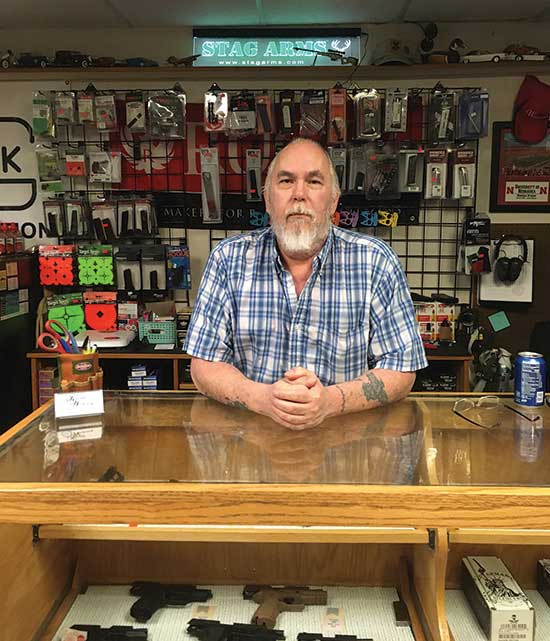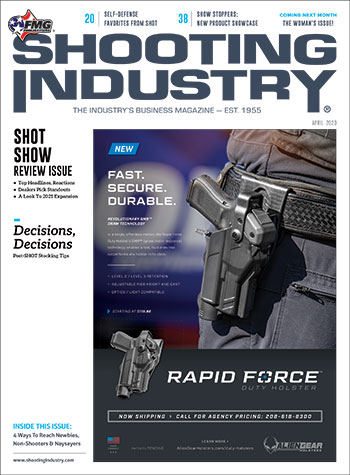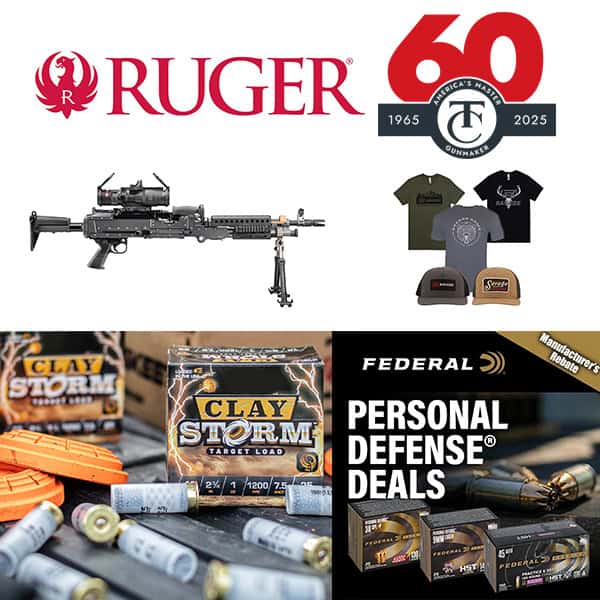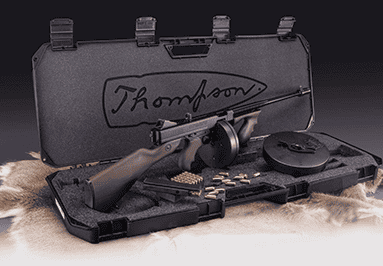Decisions, Decisions
Tips For Getting Your New Product Inventory Right
Another SHOT show is in the books. Now comes the daunting task of figuring out what to make of all the new firearms and accessories announced during (or before) the Las Vegas expo.
Whether you have 1,000 or 10,000 square feet of retail space, you have decisions to make. Which of the new guns will you make room for in your display cases? Is there a new piece of gear certain to be a hit with customers? Perhaps more importantly, can you guess which of these items would be better handled with a wait-and-see approach?
Of course, there are some easy calls, GLOCK, for example.
“You’ve got GLOCK owners who want everything, whether it makes sense or not,” said Rex Gore, president of Black Wing Shooting Center in Delaware, Ohio.
“There are always those products you hadn’t even
conceived of. You say ‘Damn, that’s a good idea.’”
Adam Bryce President of GunRunner Arms Junction City, Ore.
He also has his eye on a couple of other new entrants, including Smith & Wesson’s M&P9 Shield EZ and the new Ruger-57. Both were announced ahead of SHOT — a fact that helped Gore make the decision to skip the show this year, after attending the previous 25 years. Much of the new stuff is being announced before the event even starts.
“Everyone wants to one-up the next guy,” he declared. “So why hold it for SHOT Show?”
For Adam Bryce, president of GunRunner Arms in Junction City, Ore., the show still represents an opportunity to get an early look at some of the new innovations offered by smaller, lesser-known manufacturers.
It’s not to say he’s skipping the bigger stuff. Along with the GLOCK 44, Colt’s new Python is near the top of his list: “I’ll have a couple of those in my cabinet as soon as I can get them,” he shared.
Bryce is also expecting to come across a few other promising gadgets, as he has in previous years. Among the things he and his team have discovered in the past were UniqueTek’s reloading press upgrades, including a micrometer for the powder measure. He also picked up a new holster line after watching a demonstration where a woman did somersaults without losing her gun.
“There are always those products you hadn’t even conceived of. You say ‘Damn, that’s a good idea,’” Bryce noted.
Overcoming Hard Knocks
Sometimes the stuff that looks good at SHOT doesn’t work so well in the real world. Bryce remembers, for example, picking up a promising but pricey bipod: “They never really sold. We ended up dumping them at cost.”
The ill-fated Hudson H9, which made a splash at the 2017 show, offers a reminder of what can happen with the exciting startups. Gore, from Black Wing, brought a few of those guns into his store.
“You learn from the school of hard knocks what you should carry and what you shouldn’t,” he said.
It’s one of the reasons Gore takes a more cautious approach with guns offered by unproven manufacturers. He might order a couple just to see how they do. He can’t afford to take in a bunch of lemons, considering his shop offers a lifetime warranty on every firearm sold.
Sometimes bad buying decisions can be avoided with the help of friends — or knowledgeable sales reps from buying groups.
“Occasionally, manufacturers get a little ahead of themselves,” said Marlon Knapp, of Knapp Weaponry in Wichita, Kan.
Such was the case with the first version of KelTec’s PMR-30, introduced back in 2010. Knapp remembers his sales reps urging him to stay away from the gun until the manufacturer worked out some issues.
“We didn’t stock them and we warned our customers who wanted to special order them,” he said. “Sure enough, those guns had to go back to the manufacturer.”
The Final Verdict
So, when it’s not a slam-dunk decision, how do you decide when to bring that new product into the store?
Knapp, who doesn’t attend SHOT, spends a lot of time reading industry news and watching videos (made by regular people) of the new products. With guns, he pays particular attention to range day performances, with the idea manufacturers are bringing the best versions of their new stuff.
“If they have problems with those, you know the ones they ship out to stores are going to be trouble,” he added.
Knapp also checks in on social media to look for possible hits — or duds. He’ll follow Facebook discussions, comments on stories and firearm forums. He uses a spreadsheet to track the stuff with the most potential.
In the end, it’s his customers who wield the most influence on decisions. He waits until he’s certain of demand before making an investment.
“The key is to get [employees] engaged in
the decision-making process. If they’re not invested
in it, they don’t tend to sell it as well.”
Rex Gore President of Black Wing Shooting Center Delaware, Ohio
“It usually puts us just a tiny bit behind the curve, but I’m also not stuck with a bunch of inventory I can’t sell,” Knapp said. “As with everything gun related in the industry, it’s a crapshoot in terms of predicting what’s going to be popular.”
Case in point for him is the wildly popular 6.5 Creedmoor. When it came out, he wasn’t initially impressed.
“I just thought it would be another specialty cartridge the tactical guys would want,” he said. “It surprised me when it took off.”
In Ohio, Gore relies heavily on his staff of 30 employees to help sift through all the new stuff, with a particular emphasis on what salespeople are hearing from customers.
“The key is to get them engaged in the decision-making process,” Gore observed. “If they’re not invested in it, they don’t tend to sell it as well.”
Gore, like the other shop owners, also stresses the need to make sure decisions involve people who might see things (and customer needs) a bit differently. In Gore’s case, that’s his son, who has been behind the push to add things like ZEV Technologies’ GLOCKs, AR pistols and a line of guns by B&T.
“He’s brought in some things I wouldn’t have bought,” Gore admitted. “I’ve been surprised at how well some of those have done.”
For Bryce in Oregon, the process starts at SHOT, where he and his sons will fan out through the exhibits, taking in as much as they can and keep an eye out for promising additions.
“We split up as soon as we get there and we get together at the end of the day to discuss things,” Bryce said.
Tracking Post-Show Trends
After the show, Bryce and his team will follow discussions on social media and popular internet forums like The High Road. “Between us, we usually catch every new trend that comes along,” he said.
Then they’ll track customer requests for firearms not already carried in house. When enough requests come in, he’ll order extras for the store. Of course, even this approach offers no guarantees.
“I’ve been burned a couple times,” he recalled. “As soon as you start carrying them, the demand dries up.”
Bryce’s model, however, is not one that lends itself to early adoption of guns offered by new companies. They make most of their purchases through a network of wholesalers. So it generally leaves them out of the niche production markets “unless they’ve got something that just really impresses me,” he concluded.
What is your post-SHOT Show stocking strategy? Let the SI Team know! comments@shootingindustry.com.








